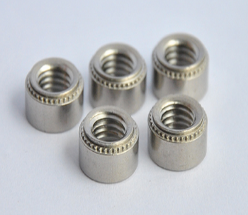Self clinching nuts play a pivotal role in today's industrial production. Pressure riveting screws are divided into free-cutting steel pressure riveting screws, Stainless Steel Pressure Riveting Screws and copper and aluminum pressure riveting screws in terms of raw materials, which should be used in different environments. Standards are usually used mostly from M2 to M6. There is no unified national standard for pressure riveting screws, only professional standards. Commonly used in electronics, communications, electrical appliances, chassis, cabinets, sheet metal and other industries. The quality of the product must not be careless and must be inspected strictly in accordance with the corresponding standards. So what are the inspection standards for rivet nuts?

First of all, the PEM rivet nut is also the evolution of the national standard rivet screw, and the specific inspection items must be determined according to the national standard rivet screw surface defect specification. For details, please refer to the corresponding national standard. If the surface coating and plating affect the surface defect If identified, they should be removed before the inspection.
Secondly, according to the requirements of the design drawings), the external dimensions of the PEM rivet nuts, self clinching fasteners and raw materials should be inspected. This should pay attention to the inspection of raw materials. First, raw material manufacturers should provide raw material certificate reports. The initial press-in stage of the riveting screw sheet starts from the punch 1 touching the upper sheet and stops when the push rod 5 reaches the dead point. In this process, the upper sheet material is bent and deformed under the extrusion force of the punch 1, and the plastic deformation occurs locally. At this stage, the upper and lower sheets are mainly elastically deformed, accompanied by a small amount of plastic deformation. Second, the product must have the SGS raw material certification, and send it to the relevant laboratory for raw material composition analysis to confirm whether the composition content meets the raw material requirements of the drawing.
Again, functional requirements, non-destructive inspection, if any quenching cracks on any part, wrinkles on the supporting surface and below are found during the non-destructive inspection of the PEM rivet nut, and whether the coating meets the Rosh environmental protection requirements, etc. The initial press-in stage of the riveting screw sheet starts from the punch 1 touching the upper sheet and stops when the push rod 5 reaches the dead point. In this process, the upper sheet material is bent and deformed under the extrusion force of the punch 1, and the plastic deformation occurs locally. At this stage, the upper and lower sheets are mainly elastically deformed, accompanied by a small amount of plastic deformation. Standoffs are divided into SO type of fast-cutting steel through-hole standoffs, SOS type of stainless steel through-hole standoffs, BSO type of fast-cutting steel blind-hole standoffs and stainless steel blind standoffs in terms of raw materials and internal threads. There are four types of BSOS types of hole pressure riveting nuts, which are respectively used in different application environments.
Then there is the destructive inspection, such as the corresponding hardness impact test for the hardness level of the rivet nut; the internal hardness, mechanical properties, torque test, etc. will damage the PEM rivet nut, but the rivet screw factory with a strong sense of quality is here These are all items that need to be tested. We also have Self Clinching Screws for sale, if you are interested, please contact us.